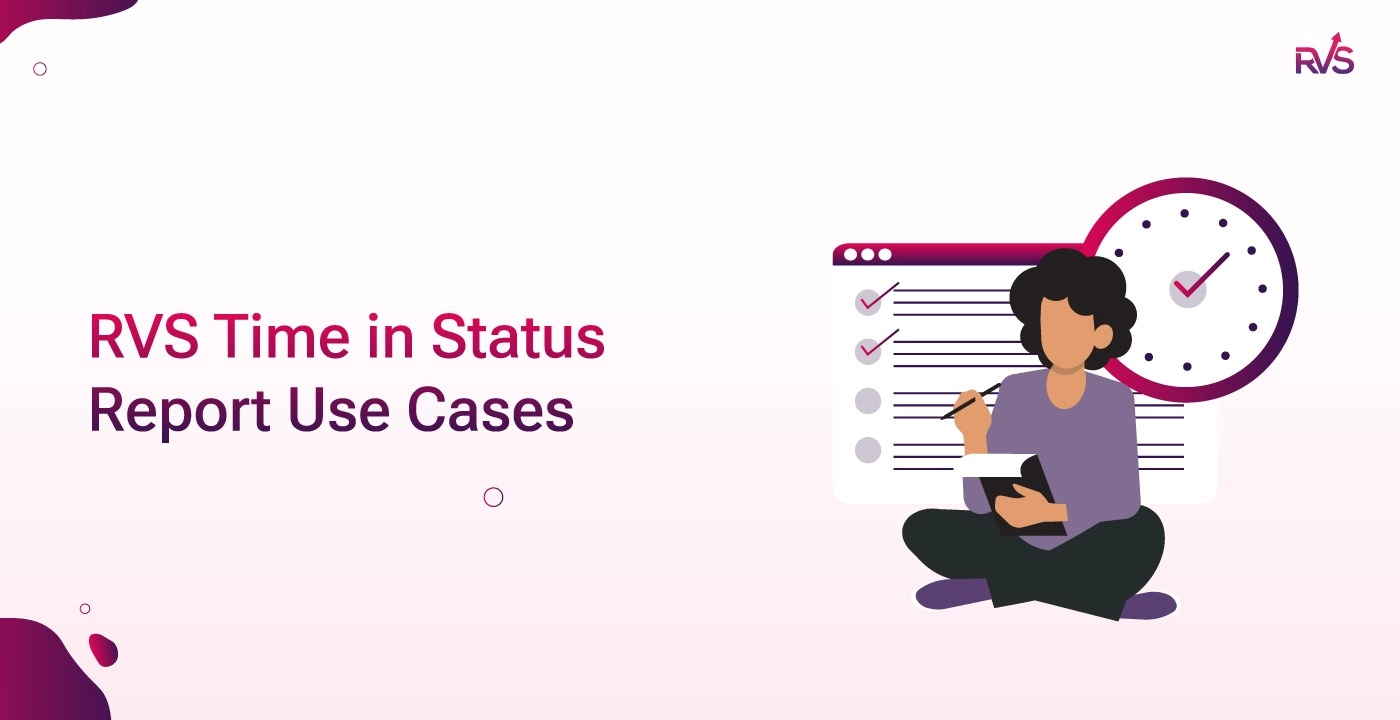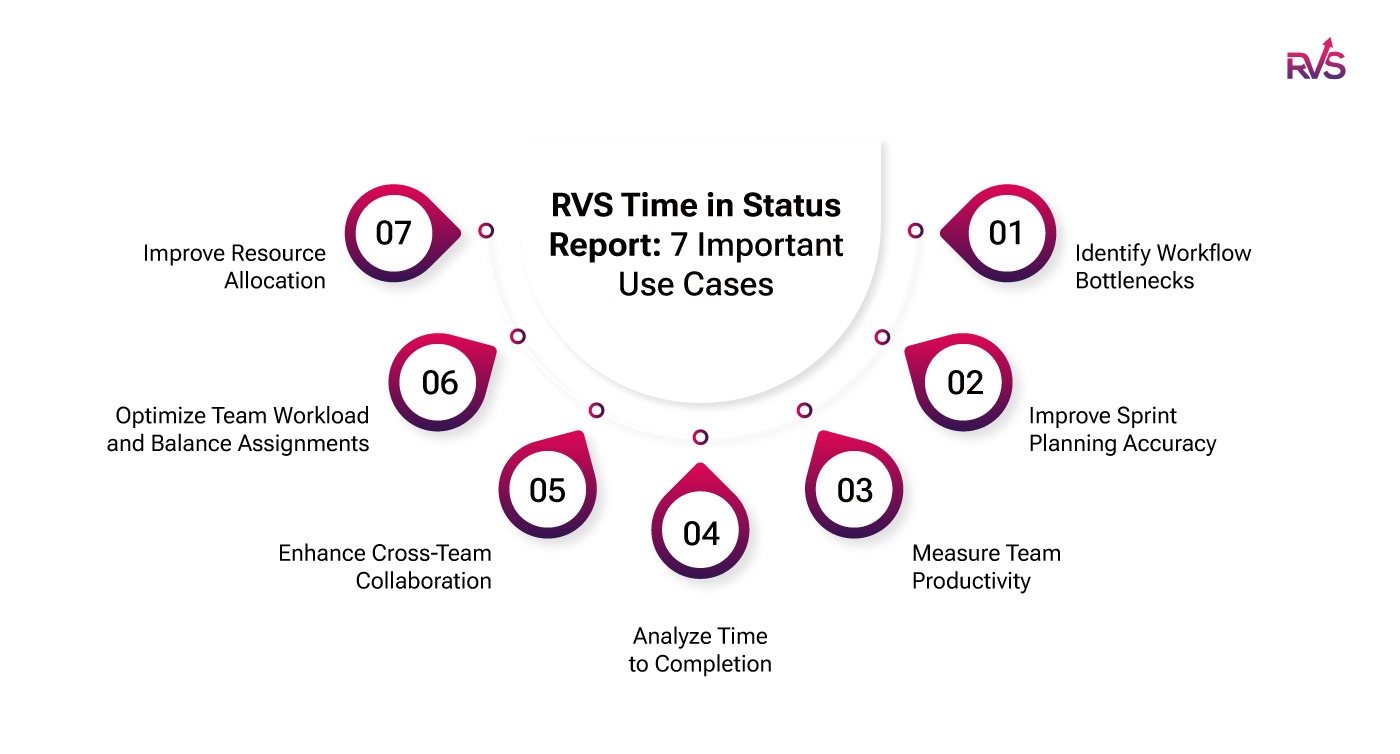Jira's Time in Status report by RVS is a powerful tool that helps teams analyze workflow efficiency, identify bottlenecks, and optimize processes. Here are some real-world use cases

Project managers, Agile teams, and service desk professionals are always looking for ways to gain deeper insights into their workflows. Without visibility into how long tasks spend in each stage, bottlenecks can easily go unnoticed, and valuable time is wasted—leading to delays and frustration.
That’s where the Jira Time in Status Report from RVS Softek truly shines. This powerful tool provides real-time, accurate data on how long tasks spend in each Jira status, empowering teams to make data-driven decisions.
By eliminating inefficiencies and improving workflow visibility, RVS Time in Status Report helps teams stay on track, meet deadlines, and drive better overall performance.
In this blog, we’ll walk through seven practical use cases that demonstrate how teams across various industries are leveraging this tool to maximize productivity and drive results.
Visibility into each stage of a project is a must-have for modern teams. Whether you're working in Agile sprints or managing a customer support queue, tracking how long issues stay in each Jira status can provide critical insights into your team’s performance.
Tracking time in status ensures that project managers have a real-time understanding of workflow management and can act quickly to resolve delays before they escalate.

The RVS Time in Status Report for Jira, powered by RVS Softek, integrates seamlessly into your project management workflow. This app for Jira automatically tracks how long each issue spends in every Jira status (e.g., "To Do," "In Progress," "Done"), providing detailed, actionable reports that help you optimize your workflow and make data-driven decisions.
By giving teams the power to change Jira status and track time across all statuses, RVS Time in Status Report helps ensure projects stay on track, goals are met, and deadlines are respected.

Jira's Time in Status report by RVS is a powerful tool that helps teams analyze workflow efficiency, identify bottlenecks, and optimize processes. Here are some real-world use cases:
For example, if the "In Progress" status consistently has issues that linger for a week, it’s clear that a rebalancing of resources or process improvements is needed.
For example, if the gadget shows that tasks typically spend an average of 3 days in the "Testing" status, the team can factor this into their sprint estimates. This data-driven approach helps teams plan more accurately and avoid underestimating or overloading tasks in the next sprint.
On the other hand, if the "QA" status is always taking longer than expected, it may suggest that the testing process needs to be optimized.
For example, if a feature consistently takes 3 days in "Development" and 2 days in "Testing," teams can focus on optimizing these stages to speed up the delivery process.
For instance, if the "Development" stage is finished, but the task is waiting for QA approval, the tool can help identify this hold-up and allow the QA team to prioritize or speed up their review process.
For example, if one team member is consistently receiving more issues during specific sprints, managers can redistribute tasks more evenly, ensuring a balanced workload for the entire team.
Ready to streamline your workflow? Try Time in Status Reports now on Atlassian and experience the difference!
The RVS Time in Status Report for Jira provides a clear, actionable view of how long tasks spend in each status, empowering teams to identify bottlenecks, optimize workflows, and meet deadlines.
Whether you're improving sprint planning or measuring team productivity, RVS Time in Status Reports offers the insights necessary to boost efficiency and drive better project outcomes.
By implementing this tool, teams can unlock valuable data that allows them to optimize their Jira workflows, ultimately leading to faster delivery, higher quality, and greater satisfaction for stakeholders.
Start using RVS Time in Status now and begin streamlining your team's workflow. Track, optimize, and accelerate project delivery like never before.
Ready to improve your workflow? Book your RVS demo today.
1. How does RVS Time in Status Report help improve project workflows in Jira?
The RVS Time in Status Report for Jira tracks how long each issue spends in each status, helping project managers identify bottlenecks and optimize workflows. By visualizing status transitions and durations, teams can make data-driven decisions, improve efficiency, and deliver projects faster.
2. How do I generate the average time in status per issue in Jira?
To generate the average time in status per issue in Jira, simply use the RVS Time in Status Gadget. This tool provides a detailed breakdown of how long issues spend in each status, allowing you to track averages and identify stages that need improvement.
3. How can Jira Time in Status metrics benefit Agile teams?
Jira Time in Status metrics are essential for Agile teams, as they allow you to track the time each task spends in various workflow stages. This visibility helps teams improve sprint planning, reduce cycle times, and focus on optimizing bottleneck areas for smoother, faster project delivery.
4. Can RVS Time in Status Report help reduce SLA breaches in Jira?
Yes! RVS Time in Status Report provides real-time data on how long tasks stay in each status, helping teams spot inefficiencies that may lead to SLA breaches. By tracking these time metrics, teams can make proactive adjustments to meet deadlines and maintain service levels.
5. How can I optimize my team’s workflow using Jira Time in Status Tool?
The Jira Time in Status Tool by RVS Softek provides real-time insights into task progress and status durations. By analyzing this data, you can pinpoint inefficiencies, redistribute workloads, and streamline processes to optimize your team's overall performance and accelerate project delivery.
6. What are the key Jira Time in Status metrics for Agile teams to track?
Key Jira Time in Status metrics for Agile teams include the time spent in each status, status transition times, and the average time per issue. These metrics help Agile teams identify bottlenecks, improve sprint planning, and ensure tasks move smoothly through each phase of development.
8. How can RVS Time in Status improve sprint planning for Agile teams?
RVS Time in Status helps Agile teams improve sprint planning by providing detailed insights into how long tasks spend in each status. By analyzing historical data, teams can make more accurate estimates, optimize workflows, and allocate resources efficiently to ensure timely delivery of sprints.
December 3, 2025
Explore the role of workflow analytics in boosting Jira productivity. This blog covers how tracking task transitions, identifying bottlenecks, and optimizing workflows with tools like RVS Softek can enhance team performance and deliver projects faster.
Read MoreDecember 2, 2025
Learn how to read and optimize Jira time tracking reports for better project visibility, accurate insights, and improved team efficiency using smart tools.
Read MoreNovember 18, 2025
Learn how to use SLA in Jira for better tracking, faster resolutions, and improved team performance. Explore expert tips and tools for SLA automation.
Read More